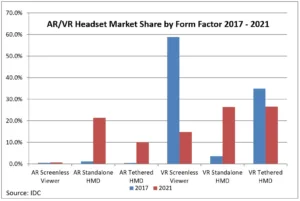Worldwide proliferation of VR and AR headsets is expected to continue as shipments reach 59.2 million in 2021, up from 9.6 million in 2017, according to IDC.
To date, the entire market has been propped up by low-cost VR screenless viewers such as the Samsung Gear VR. However, IDC anticipates this category will lose share as previous champions of the category scale back on their smartphone-headset bundles and shift focus toward tethered and standalone solutions. VR screenless viewers will account for 14.8% of the entire market in 2021, down from 58.8% in 2017.
Over the course of the next few years, tethered headsets from the likes of Sony or Meta will account for the majority of shipments and in 2021, standalone headsets like the Oculus Go or Hololens will take centre stage, accounting for almost half of the AR/VR headset market. Jitesh Ubrani, senior research analyst for IDC’s Mobile Device Trackers, said:
“The VR market, young as it is, is in the midst of a crucial transition as buyers are gravitating towards tethered headset and PC or game console bundles that offer advanced tracking and higher fidelity rather than settling for low-cost headset and smartphone bundles. This bodes well for the entire VR ecosystem as the improved experience of a dedicated device draws a more dedicated audience.”
Traction for VR tethered and standalone VR headsets will not be limited to the consumer market, as commercial shipments for these headsets will climb from 1 million in 2017 to 12.6 million by the end of 2021. Meanwhile, augmented reality headsets are on track to have a significantly larger impact in the commerical segment, as shipments grow to 15.6 million in the same time period. Ryan Reith, program vice president with IDC’s Worldwide Quarterly Mobile Device Trackers, also commented:
“We have long believed that AR headsets will play a fundamental role in changing the way many companies do business in the near future and we are increasingly seeing the commercial use cases for VR unfold. AR will introduce technology to a large portion of the workforce that was never able to benefit from technological advances because of the need to use their hands to complete their job functionality.
AR will change all that and within VR, the commercial use cases that are emerging the fastest are within education, design and content creation, and retail. We have strong reason to believe this is just the tip of the iceberg.”

This data represents forecast shipments of Virtual Reality and Augmented Reality headsets only. Any additional software, services, or computing devices (e.g. PC, game console, smartphone, etc.) are excluded.
Shipments of simplistic headsets that do not have any technology built in are excluded. Examples of such headsets include Google Cardboard and other Cardboard-like devices.

